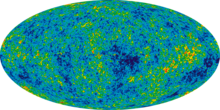Our website is made possible by displaying online advertisements to our visitors.
Please consider supporting us by disabling your ad blocker.
Galaxy filament

| Part of a series on |
| Physical cosmology |
|---|
 |
In cosmology, galaxy filaments are the largest known structures in the universe, consisting of walls of galactic superclusters. These massive, thread-like formations can commonly reach 50 to 80 megaparsecs (160 to 260 megalight-years)—with the largest found to date being the Hercules-Corona Borealis Great Wall at around 3 gigaparsecs (9.8 Gly) in length—and form the boundaries between voids.[1] Due to the accelerating expansion of the universe, the individual clusters of gravitationally bound galaxies that make up galaxy filaments are moving away from each other at an accelerated rate; in the far future they will dissolve.[2]
Galaxy filaments form the cosmic web and define the overall structure of the observable universe.[3][4][5]
- ^ Bharadwaj, Somnath; Bhavsar, Suketu; Sheth, Jatush V (2004). "The Size of the Longest Filaments in the Universe". Astrophys J. 606 (1): 25–31. arXiv:astro-ph/0311342. Bibcode:2004ApJ...606...25B. doi:10.1086/382140. S2CID 10473973.
- ^ Siegel, Ethan. "Our Home Supercluster, Laniakea, Is Dissolving Before Our Eyes". Forbes. Retrieved 2023-11-13.
- ^ "Cosmic Web". NASA Universe Exploration. Archived from the original on 2023-03-27. Retrieved 2023-06-06.
- ^ Komberg, B. V.; Kravtsov, A. V.; Lukash, V. N. (October 1996). "The search for and investigation of large quasar groups". Monthly Notices of the Royal Astronomical Society. 282 (3): 713–722. arXiv:astro-ph/9602090. Bibcode:1996MNRAS.282..713K. doi:10.1093/mnras/282.3.713. ISSN 0035-8711.
- ^ Clowes, R. G. (2001). "Large Quasar Groups - A Short Review". Astronomical Society of the Pacific. 232: 108. Bibcode:2001ASPC..232..108C. ISBN 1-58381-065-X.
Previous Page Next Page


